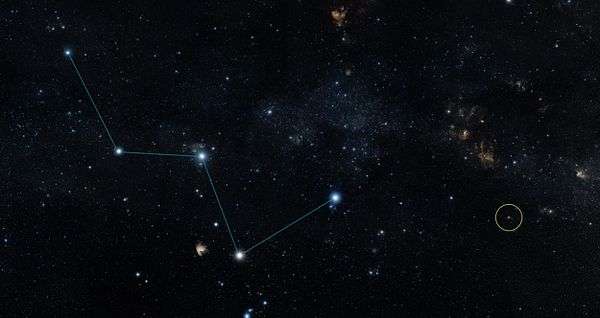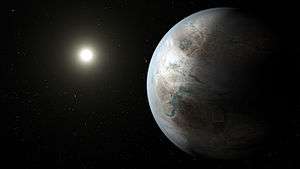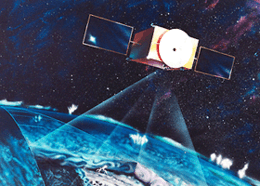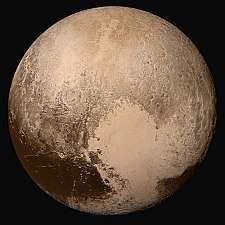HD 219134 b
| Exoplanet | List of exoplanets | |
|---|---|---|
 | ||
| Parent star | ||
| Star | HR 8832 | |
| Constellation | Cassiopeia | |
| Right ascension | (α) | 23h 13m 16.9763s[1] |
| Declination | (δ) | +57° 10′ 06.082″[2] |
| Apparent magnitude | (mV) | 5.574[3] |
| Distance | 21.25[4] ly (6.52 pc) | |
| Spectral type | K3V[5] | |
| Mass | (m) | 0.81 ± 0.03[6] M☉ |
| Radius | (r) | 0.778 ± 0.005[6] R☉ |
| Temperature | (T) | 4699[6] K |
| Metallicity | [Fe/H] | +0.11[6] |
| Age | 11[6] Gyr | |
| Orbital elements | ||
| Semi-major axis | (a) | 0.038764 (± 0.0047)[7] AU |
| Eccentricity | (e) | 0 (fixed)[7] |
| Orbital period | (P) | 3.092926 (± 0.0004)[7] d |
| Inclination | (i) | 85.058 ± 0.08[7]° |
| Physical characteristics | ||
| Mass | (m) | 4.74 (± 0.19)[7] M⊕ |
| Radius | (r) | 1.602±0.055[8] R⊕ |
| Stellar flux | (F⊙) | 176.2 (± 5.5) ⊕ |
| Density | (ρ) | 6.36 (± 0.72)[7] g cm−3 |
| Surface gravity | (g) | 1.847 +0.213 −0.19 g |
| Temperature | (T) | 1,015 K (742 °C; 1,367 °F) |
| Discovery information | ||
| Discovery date | 30 July 2015 | |
| Discoverer(s) | ||
| Discovery method | radial velocity method (HARPS-N) | |
| Other detection methods | transiting (Spitzer telescope) | |
| Discovery site | HARPS-N of the Telescopio Nazionale Galileo | |
| Discovery status | Published | |
| Database references | ||
| Extrasolar Planets Encyclopaedia | data | |
| SIMBAD | data | |
| Exoplanet Archive | data | |
| Open Exoplanet Catalogue | data | |
HD 219134 b (or HR 8832 b) is one of at least five exoplanets orbiting HR 8832, a main-sequence star in the constellation of Cassiopeia.[4][7][9][10] As of July 2015, super-Earth HD 219134 b, with a size of about 1.6 R⊕, and a density of 6.4 g/cm3, was reported as the closest rocky exoplanet to the Earth, at 21.25 light-years away.[4] The exoplanet was initially detected by the instrument HARPS-N of the Italian Telescopio Nazionale Galileo via the radial velocity method and subsequently observed by the Spitzer telescope as transiting in front of its star.[4][9] The exoplanet has a mass of about 4.5 times that of Earth and orbits its host star every three days.[4] In 2017, it was found that the planet likely hosts an atmosphere.
Characteristics
Mass, radius and temperature
HD 219134 b is a super-Earth, an exoplanet with a radius and mass bigger than Earth, but smaller than that of the ice giants Neptune and Uranus. Using both the radial velocity and transit method, both its mass and radius have been well determined, allowing for accurate modelling of the planet's composition. HD 219134 b has a radius of 1.602 R⊕ and a mass of 4.74 M⊕, giving it a density of about 6.4 g/cm3 and 1.85 times the gravity of Earth. This is consistent with a rocky, Earth-like composition. This is relatively unusual, as most planets of ≥1.6 R⊕ are expected to be rich in volatile materials, such as water and gas. Despite its Earth-like composition, the planet's equilibrium temperature is around 1,015 K (742 °C; 1,367 °F), far too hot for liquid water or life. Depending on the amount of cloud cover in the atmosphere of HD 219134 b, the actual temperature may be somewhat lower, but nowhere near the range for liquid water.
Host star
The planet orbits a (K-type) star named HR 8832, orbited by a total of five to seven planets. The star has a mass of 0.81 M☉ and a radius of 0.778 R☉. It has a temperature of 4699 K and is about 11.0 billion years old, making it one of the oldest stars. In comparison, the Sun is 4.6 billion years old[11] and has a temperature of 5778 K.[12]
The star's apparent magnitude, or how bright it appears from Earth's perspective, is 5. It can be seen with the naked eye.
Orbit
HD 219134 b orbits its host star with about 28% of the Sun's luminosity with an orbital period of 3 days and an orbital radius of about 0.03 times that of Earth's (compared to the distance of Mercury from the Sun, which is about 0.38 AU).
Atmosphere
In 2017, it was predicted that HD 219134 b and HD 219134 c likely have atmospheres that are secondary in nature, based on the compositions of the planets and the potential for atmospheric escape. For HD 219134 b, the predicted atmosphere was calculated to reach a height of about 0.18 R⊕ (~1,150 km), below the predicted height of a primordial hydrogen atmosphere (0.28 R⊕). This would indicate a secondary atmosphere produced by processes like volcanic activity and evaporation of volatile materials. However, the composition of volatile materials on HD 219134 b and c could not be accurately determined, yet it is believed that the former has a very thin gaseous envelope, far thinner than those of Uranus and Neptune.[13]
Gallery

(00:53; animation; July 30, 2015).
See also
- List of exoplanet extremes
- Other rocky planets with confirmed atmospheres:
- TRAPPIST-1b and TRAPPIST-1c
- Gliese 1132 b, has an atmosphere rich in water and methane.
- 55 Cancri e, has an atmosphere with hydrogen, helium, hydrogen cyanide, nitrogen, and/or carbon monoxide.
References
- ↑ Rajpaul, V. (July 2017), "Pinning down the mass of Kepler-10c: the importance of sampling and model comparison", Astronomy and Astrophysics, 474 (2): 653–664, arXiv:0708.1752, Bibcode:2007A&A...474..653V, doi:10.1051/0004-6361:20078357.
- ↑ van Leeuwen, F. (November 2007), "Validation of the new Hipparcos reduction", Astronomy and Astrophysics, 474 (2): 653–664, arXiv:0708.1752, Bibcode:2007A&A...474..653V, doi:10.1051/0004-6361:20078357.
- ↑ Oja, T. (August 1986), "UBV photometry of stars whose positions are accurately known. III", Astronomy and Astrophysics Supplement Series, 65 (2): 405–409, Bibcode:1986A&AS...65..405O.
- 1 2 3 4 5 Chou, Felicia; Clavin, Whitney (30 July 2015). "NASA's Spitzer Confirms Closest Rocky Exoplanet". NASA. Retrieved 31 July 2015.
- ↑ Frasca, A.; et al. (December 2009), "REM near-IR and optical photometric monitoring of pre-main sequence stars in Orion. Rotation periods and starspot parameters", Astronomy and Astrophysics, 508 (3): 1313–1330, arXiv:0911.0760, Bibcode:2009A&A...508.1313F, doi:10.1051/0004-6361/200913327.
- 1 2 3 4 5 "HD 219134". exoplanetarchive.ipac.caltech.edu. Retrieved 2017-12-26.
- 1 2 3 4 5 6 7 Motalebi, F.; et al. "The HARPS-N Rocky Planet Search, I. HD 219134b: A transiting rocky planet in a multi-planet system at 6.5 pc from the Sun". Astronomy and Astrophysics. arXiv:1507.08532. Bibcode:2015A&A...584A..72M. doi:10.1051/0004-6361/201526822.
- ↑ Gillon, Michaël; et al. (2017). "Two massive rocky planets transiting a K-dwarf 6.5 parsecs away". Nature Astronomy. 1. 0056. arXiv:1703.01430. Bibcode:2017NatAs...1E..56G. doi:10.1038/s41550-017-0056.
- 1 2 "PIA19832: Location of Nearest Rocky Exoplanet Known". NASA. 30 July 2015. Retrieved 30 July 2015.
- ↑ "HD 219134". exoplanetarchive.ipac.caltech.edu.
- ↑ Fraser Cain (16 September 2008). "How Old is the Sun?". Universe Today. Retrieved 19 February 2011.
- ↑ Fraser Cain (15 September 2008). "Temperature of the Sun". Universe Today. Retrieved 19 February 2011.
- ↑ https://arxiv.org/pdf/1711.07745.pdf


